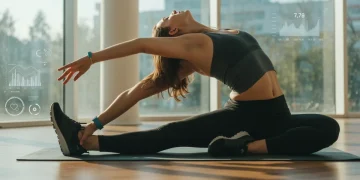Sustainable Fitness: Crafting a Routine You Can Stick With Long-Term

Building a truly sustainable fitness routine involves prioritizing enjoyment, realistic goals, and adaptability to ensure long-term adherence and continuous health benefits beyond just five years.
In a world often driven by quick fixes and fleeting trends, the concept of sustainable fitness routine emerges as a beacon for lasting health and well-being. This isn’t about intense, short-lived challenges, but rather about cultivating habits that seamlessly integrate into your life, promising vitality for not just a few months, but for five years and beyond, starting right now in 2025.
Understanding the Core of Sustainable Fitness
Sustainable fitness is fundamentally about creating a physical activity regimen that you can maintain consistently over a long period without burnout, injury, or loss of motivation. It’s a holistic approach that considers your physical, mental, and emotional well-being, ensuring that your fitness journey is a marathon, not a sprint.
Many people embark on ambitious fitness plans only to abandon them after a few weeks or months. This often stems from unrealistic expectations, a lack of enjoyment, or an inability to adapt to life’s inevitable changes. A sustainable approach counters these pitfalls by fostering intrinsic motivation and flexibility.
Defining Your ‘Why’ for Long-Term Engagement
Before you even think about specific exercises, it’s crucial to identify your underlying motivations. What truly drives you to be active? Is it improved health, greater energy, stress relief, or simply the joy of movement? Understanding this core purpose provides a powerful foundation for building a routine that resonates deeply with your personal values.
- Health Benefits: Focus on long-term disease prevention and enhanced quality of life.
- Mental Well-being: Recognize fitness as a tool for stress reduction and mood improvement.
- Personal Challenge: Embrace the satisfaction of achieving personal milestones.
- Social Connection: Find joy in group activities and shared fitness experiences.
By clearly articulating your ‘why,’ you create a personal anchor that will keep you committed even when motivation wanes. This intrinsic drive is far more powerful than external pressures or fleeting trends, ensuring your fitness journey remains meaningful and enduring.
Setting Realistic and Evolving Goals
The journey to sustainable fitness begins with setting goals that are not only achievable but also flexible enough to evolve as you do. While ambitious targets can be motivating in the short term, they often lead to frustration and abandonment if they are not grounded in reality or allow for life’s unpredictability.
Instead of focusing solely on outcome-based goals like losing a certain amount of weight, consider process-oriented goals. These might include committing to a certain number of workouts per week, trying a new physical activity every month, or simply increasing your daily step count. Process goals provide a sense of accomplishment more frequently, reinforcing positive habits.
The Power of Small, Consistent Steps
Think about building your fitness routine like constructing a house, brick by brick. Each small, consistent effort contributes to a strong, resilient structure. Starting with manageable workouts, even just 15-20 minutes a day, is far more effective than attempting an hour-long, high-intensity session that you dread and eventually skip.
Consistency is the true magic ingredient here. It builds momentum, creates habits, and makes exercise feel less like a chore and more like an integral part of your day. Gradually increasing duration or intensity as you feel stronger and more comfortable ensures steady progress without overwhelming your system or mind.
Your goals should also be dynamic. What motivates you today might not resonate in a year, and that’s perfectly normal. Regularly reassess your fitness objectives and adjust them to align with your current life circumstances, interests, and physical capabilities. This adaptability is key to maintaining engagement over the long haul, preventing stagnation and boredom.
Finding Enjoyment in Movement
One of the most critical, yet often overlooked, aspects of a truly sustainable fitness routine is enjoyment. If you dread your workouts, it’s highly unlikely you’ll stick with them for five years. The key is to discover activities that you genuinely look forward to, making exercise a source of pleasure rather than a burden.
This might mean stepping outside the traditional gym setting. Perhaps you find joy in hiking, dancing, swimming, cycling, or playing a sport. The options are limitless, and the right fit for you is the one that makes you feel good, both physically and mentally. Experimentation is vital here; try different things until you find what clicks.


Integrating Variety and Playfulness
Monotony is the enemy of sustainability. Incorporating variety into your routine keeps things fresh and engages different muscle groups, reducing the risk of overuse injuries. This doesn’t mean you need a completely new workout every day, but rather a mix of activities that challenge your body in different ways.
- Cardiovascular Activities: Running, swimming, cycling, brisk walking.
- Strength Training: Bodyweight exercises, free weights, resistance bands.
- Flexibility and Balance: Yoga, Pilates, stretching routines.
- Recreational Sports: Tennis, basketball, hiking, dancing.
Think of your fitness journey as a playground. How can you make it more playful? Can you turn a walk into a scavenger hunt, or a strength session into a game? Infusing an element of fun can transform your perspective on exercise, making it something you crave rather than something you tolerate. Moreover, this approach helps maintain enthusiasm and prevents the mental fatigue often associated with rigid, unvarying routines.
The Role of Adaptability and Flexibility
Life is unpredictable, and expecting your fitness routine to remain rigid in the face of illness, travel, work demands, or family obligations is a recipe for failure. A truly sustainable fitness plan is one that can bend without breaking, adapting to whatever challenges life throws your way.
This means having backup plans. If you can’t make it to the gym, can you do a quick bodyweight circuit at home? If you’re traveling, can you find local walking trails or use hotel gym facilities? Prioritizing movement, even in smaller doses, over perfection is key. The goal is consistent effort, not flawless execution.
Listening to Your Body and Preventing Burnout
Over-training is as detrimental to long-term fitness as under-training. Ignoring your body’s signals for rest or modification can lead to injuries, exhaustion, and a complete loss of motivation. Sustainable fitness requires a deep connection to your body, understanding its limits, and respecting its needs.
This involves incorporating adequate rest and recovery into your schedule, just as you would schedule your workouts. It also means being willing to modify or skip a workout if you’re feeling unwell, overly fatigued, or experiencing pain. Pushing through pain can have serious long-term consequences, whereas a day of rest can often be the best recovery strategy.
Embracing adaptability extends to your nutrition and sleep habits as well. These are foundational pillars of overall well-being that directly impact your ability to sustain physical activity. Ensuring you are adequately fueled and rested will enhance performance, aid recovery, and significantly reduce the risk of burnout, making your fitness journey more enjoyable and achievable for years to come.
Building a Supportive Environment
Your environment plays a significant role in your ability to maintain a fitness routine. Surrounding yourself with supportive people and resources can provide the encouragement and accountability needed to stay on track, especially during challenging times. This doesn’t mean you need an entire cheering squad, but rather a few key elements that foster positive habits.
Consider joining a fitness class, a running club, or finding a workout buddy. Shared experiences can make exercise more enjoyable and provide a sense of community. Even simply sharing your goals with friends or family can create a supportive network that helps keep you accountable and motivated.
Leveraging Technology and Community
In 2025, technology offers numerous tools to support your fitness journey. Fitness apps can track your progress, provide guided workouts, and even connect you with online communities. Wearable devices can monitor your activity levels, sleep patterns, and heart rate, offering valuable insights into your overall health.
- Fitness Trackers: Monitor steps, heart rate, sleep quality.
- Workout Apps: Guided routines, progress tracking, virtual coaching.
- Online Communities: Share experiences, get support, find inspiration.
- Smart Home Gyms: Interactive equipment with personalized programs.
Beyond technology, actively seeking out a supportive community, whether in-person or online, can dramatically enhance your commitment. Sharing successes and challenges with others who understand and encourage your goals creates a powerful feedback loop. This collective energy can propel you forward, transforming what might feel like an individual struggle into a shared, empowering journey, making long-term adherence much more attainable.


Integrating Fitness into Your Lifestyle
For a fitness routine to truly last five years and beyond, it cannot be an isolated event; it must become an integral part of your daily lifestyle. This means finding ways to weave physical activity into your existing schedule and habits, making it as automatic as brushing your teeth or drinking your morning coffee.
Look for opportunities to move more throughout your day. Take the stairs instead of the elevator, walk or bike for short errands, or incorporate short movement breaks into your workday. These small, consistent efforts add up significantly over time and reinforce the idea that movement is a natural and essential part of living.
Mindful Movement and Active Living
Beyond structured workouts, cultivating a mindset of mindful movement can transform your entire relationship with physical activity. This involves paying attention to how your body feels during movement, appreciating its capabilities, and choosing activities that enhance your overall well-being. It’s about moving with purpose and presence.
Active living is about embracing opportunities for physical activity in all aspects of your life. It’s about viewing your body as a tool for exploration, connection, and enjoyment, rather than just something that needs to be exercised. This broader perspective helps you stay engaged and motivated, ensuring that fitness remains a joyful and sustainable pursuit for many years to come.
By consciously integrating mindful movement and active living principles, you shift from merely exercising to embodying a lifestyle where physical activity is a natural and cherished component. This seamless integration ensures that your fitness routine isn’t just maintained, but truly thrives, contributing to a richer, healthier life for decades ahead.
Overcoming Plateaus and Maintaining Motivation
Even the most sustainable fitness journey will encounter plateaus and moments of waning motivation. This is a natural part of any long-term endeavor, and how you navigate these challenges will determine the longevity of your routine. Recognizing that these phases are temporary is the first step.
When you hit a plateau, it’s an opportunity to reassess and adjust. Perhaps you need to vary your workouts, increase intensity, or focus on a different aspect of fitness, such as flexibility or balance. Sometimes, simply taking a short break can re-energize you and help you break through.
Strategies for Renewed Engagement
Maintaining motivation over five years requires a proactive approach. Regularly setting new, exciting challenges can keep your interest piqued. This could involve training for a charity run, trying a new sport, or mastering a new skill like handstands or a complex yoga pose. Novelty is a powerful motivator.
- Set New Challenges: Train for an event, learn a new skill.
- Track Progress Visually: Use charts, apps, or journals.
- Reward Milestones: Celebrate achievements with non-food rewards.
- Seek Professional Guidance: A coach can provide fresh perspectives.
- Reconnect with Your ‘Why’: Remind yourself of your core motivations.
Moreover, regularly reflecting on your progress and celebrating small victories can significantly boost morale. Acknowledging how far you’ve come reinforces your commitment and reminds you of your inherent strength and capability. This positive reinforcement, combined with strategic adjustments, ensures that your fitness journey remains dynamic, engaging, and enduring.
| Key Aspect | Brief Description |
|---|---|
| Enjoyable Movement | Choose activities you genuinely love to ensure long-term adherence and prevent burnout. |
| Realistic Goals | Set achievable, process-oriented goals that adapt to life’s changes and avoid frustration. |
| Adaptability | Build flexibility into your routine to navigate challenges like illness, travel, or busy periods. |
| Supportive Environment | Leverage community, technology, and personal networks for encouragement and accountability. |
Frequently asked questions about sustainable fitness
Sustainable fitness, starting in 2025, means developing a physical activity regimen that is enjoyable, flexible, and adaptable enough to be maintained consistently for five years or more. It prioritizes long-term health and well-being over short-term, intense results, focusing on habits that integrate seamlessly into your daily life.
To find enjoyable fitness activities, experiment with various options beyond traditional gym workouts. Try hiking, dancing, swimming, cycling, team sports, or martial arts. The key is to discover what makes you feel good, energized, and looking forward to your next session, making it a sustainable choice.
Goal setting is crucial for long-term fitness, but it must be realistic and adaptable. Focus on process-oriented goals, like consistent weekly workouts, rather than just outcome-based ones. Regularly reassess and adjust your goals to align with your evolving life and interests, ensuring continued motivation and progress.
Preventing burnout involves listening to your body, prioritizing rest and recovery, and incorporating variety into your routine. Be flexible and willing to modify or skip workouts when needed. Also, ensure adequate nutrition and sleep, as these are fundamental for sustained energy and mental well-being.
Yes, fitness trackers and apps can be very helpful for sustainable fitness. They provide valuable data on your activity, sleep, and progress, offering insights and motivation. Many also connect you to communities, fostering accountability and support, which are vital for maintaining engagement over many years.
Conclusion
Crafting a sustainable fitness routine that you can genuinely stick with for five years and beyond, starting in 2025, is not about finding the perfect plan, but about cultivating a flexible, enjoyable, and deeply personal approach to movement. By prioritizing intrinsic motivation, setting realistic and evolving goals, embracing adaptability, fostering a supportive environment, and integrating fitness seamlessly into your lifestyle, you lay the groundwork for a lifetime of health and vitality. This journey is about progress, not perfection, ensuring that your commitment to well-being remains strong and unwavering through all of life’s changes.





